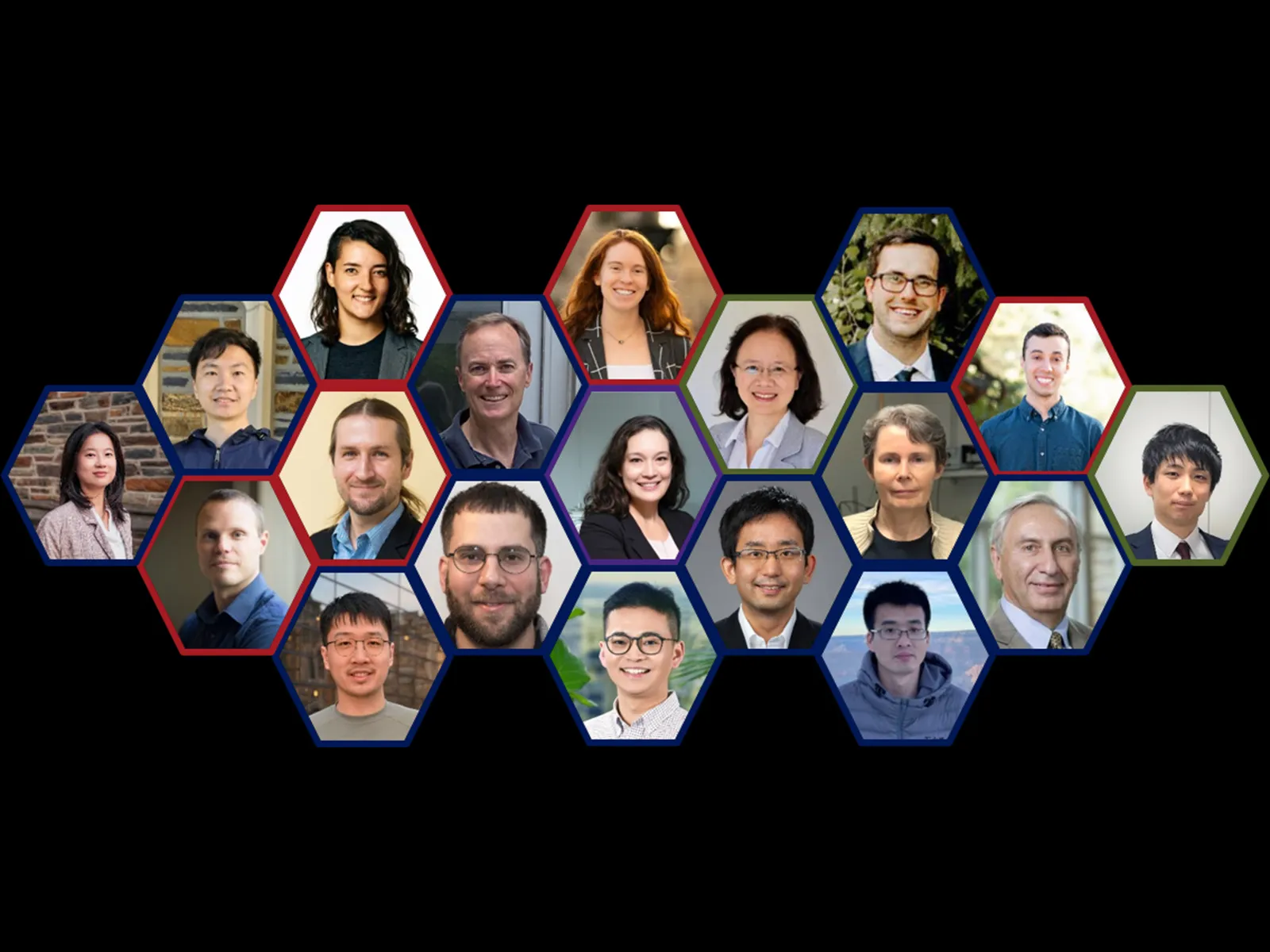Winner: 2024 Materials Chemistry Horizon Prize: Stephanie L Kwolek Prize
NSF Center for Molecularly Optimized Networks
For demonstrating the potential and impact of embedded mechanochemical reactivity on the mechanical limits of cross-linked polymer networks.

The NSF Center for Molecularly Optimized Networks brings together researchers from several institutions across the USA, spanning multiple areas of chemical expertise.
The tread of a tyre or an artificial heart valve eventually wears out due to repeated use. The team from the NSF Center for Molecularly Optimized Networks takes a creative view to understanding and addressing how stretchy materials eventually break down.
The key, it turns out, is to trigger small chemical reactions within the material while it is in use. We usually think of a chemical reaction as something that would be bad to happen in a material that we rely on to keep us safe, but the team’s work involves molecular components known as mechanophores that can be ‘turned on’ to react only at very specific and precise locations where damage is about to occur.
When the right chemistry is used, what happens in individual bonds dramatically influences the mechanical limits of the material it is embedded within. In one example, the rate at which a material tears can be slowed by roughly 100-fold, opening the way for technological advances.
The knowledge being uncovered has potential implications for biomedical implants or even commodity tyre rubber. Only a few per cent by mass of mechanophore is needed, and the effect comes without a detectable change in any other mechanical property of the material.
Michael Rubinstein: "The power of our team was that it consisted of people with very different backgrounds: synthetic and physical chemists, polymer physicists, chemical engineers …"
NSF Center for Molecularly Optimized Networks
The team
Sarah Av-Ron, Graduate Student, Massachusetts Institute of Technology
Haley K. Beech, Graduate Student, Massachusetts Institute of Technology
Brandon Bowser, Graduate Student, Duke University
Danyang Chen, Graduate Student, Duke University
Stephen L. Craig, Senior Investigator, Duke University
Jian Ping Gong, Senior Investigator, Hokkaido University
Abraham Herzog-Arbeitman, Graduate Student, Massachusetts Institute of Technology
Yixin Hu, Graduate Student, Duke University
Jeremiah A. Johnson, Senior Investigator, Massachusetts Institute of Technology
Julia A. Kalow, Senior Investigator, Northwestern University
Tatiana B. Kouznetsova, Research Analyst, Duke University
Takahiro Matsuda, Graduate Student, Hokkaido University
Bradley D. Olsen, Senior Investigator, Massachusetts Institute of Technology
Tetsu Ouchi, Postdoc, Duke University
Michael Rubinstein, Senior Investigator, Duke University
Liel Sapir, Postdoc, Duke University
Shu Wang, Graduate Student, Duke University
Zi Wang, Graduate Student, Duke University
Xujun Zheng, Postdoc, Duke University
Q&A with NSF Center for Molecularly Optimized Networks
Haley Beech: I was a researcher on this team for nearly all of my graduate student career; my main expertise was in the synthesis of model polymer networks and mechanical characterization.
Michael Rubinstein: I was PI supervising graduate students performing theoretical, computer simulation and experimental research of polymer networks.
Zi Wang: I worked on one project from end-to-end and collaboratively engaged in several projects with this team; my main work involved linear polymers and polymer networks synthesis, mechanical testings and data analysis.
Tetsu Ouchi: I was a researcher on the team. My expertise is soft matter mechanics, polymer physics, and polymer(mechano) chemistry. I brainstormed ideas and strategies, discussed the data analysis, and mentored graduate students.
Julia Kalow: My expertise is in dynamic covalent bonds, which allowed single-molecule force spectroscopy of the high-force events required to rupture these strands.
Yixin Hu: I am a graduate student who worked on one of the projects where I was involved in synthesizing weak bond mechanophores and characterizing polymer networks through fatigue tests and toughness assessments.
Brandon Bowser: My contributions to the team involved collaborative brainstorming, synthetic design and troubleshooting, and fundamental characterization of force-responsive building blocks.
Michael Rubinstein: The initial challenge was to ensure that different research groups interact and begin to collaborate. I was pleasantly surprised that within a year from the beginning of the project, we established excellent communication channels and began to work as a team.
Zi Wang: To me, it was the frontier scientific problem that require multi-discipline expertise and teams to even understand the questions better. Our regular "Tumor Board" discussions help address this greatly, which let different ideas collide and sparkle learning and innovative ideas.
Shu Wang: Connecting chemistry to the macroscale properties of polymer networks requires multidisciplinary knowledge spanning chemistry, physics, and mechanics. From a chemist’s perspective, the most challenging parts are the synthesis of bulk materials and the design of proper control experiments. Thanks to our cohesive teamwork, these challenges have finally been resolved and have become valuable experiences for the team.
Haley Beech: Coming from an engineering background, it was incredibly exciting to work with so many talented synthetic chemists. We also had fantastic leadership from Stephen Craig and the other professors on these projects who were integral in providing constant, optimistic support and facilitating strong communication across many different universities.
Michael Rubinstein: The power of our team was that it consisted of people with very different backgrounds: synthetic and physical chemists, polymer physicists, chemical engineers, etc. Each of them brought a different perspective on the problem that allowed us much deeper understanding and to perform a complete study from synthesizing networks to physical measurements and molecular dynamics simulations to test our theoretical ideas.
Abe Herzog-Arbeitman: I think our greatest strength was our ability to communicate informally about central ideas from different backgrounds. These complex phenomena became much more intuitive when many of us were able to offer different perspectives. It became clear ideas were powerful when everyone was excited by their understanding, whether they were coming from a chemistry, physics, or engineering background.
Stephen Craig: To date, the details of molecular design have been hidden by statistical chemistry and poorly defined structures, limiting the ability to bring chemical knowledge to bear on challenges in network performance and properties. We believe this is an important step in developing the chemical tools and theories that allow the impact of specific molecular behaviors on macroscopic network properties and function to be seen and optimized.
Yixin Hu: This work effectively bridges our molecular-level findings with the broader properties of polymer networks. It provides clear and fundamental insights, laying a solid foundation for future scientists to build upon and advance this field.
Julia Kalow: This work provides design rules for making polymer networks tougher based on their molecular components. While these exact molecules may not be used in tires, researchers now have a roadmap to design new comonomers and crosslinkers that will improve the lifetime and durability of essential materials.
Shu Wang: This work brings fundamental insights into the molecular design of polymer networks. For example, one of the design principles generated in this work could be used to develop new polymeric materials that last longer without altering other properties. This could potentially help us develop tougher automobile tires and mitigate the pollution generated from automobile tires.
Brandon Bowser: I have recently begun my professional career in the chemical industry and am excited to watch the MONET team and other courageous scientists continue to pursue this exciting area of research. I am confident that the research findings and molecular tools developed as a result of this research will soon be impacting the next generation of commercial materials and products made from polymers and polymer networks.
Haley Beech: I have always been very motivated by collaborative projects because I think you can learn so much more than when you are working on your own; that was especially true with the team for this project.
Abe Herzog-Arbeitman: This team is especially focused on concepts. When the guiding intuition is strong, it makes the experiments simpler and more impactful, regardless of whether they are glamorous.
Tetsu Ouchi: Passion, enthusiasm, and excitement. These factors inspired us and united us as a team.
Liel Sapir: The pursuit of fundamental, physical understanding of how polymeric materials behave, specifically when subjected to deformation.
Stephen Craig: Collaborators who change what you can do are a gift. Collaborators who change how you think are a blessing.
Danyang Chen: As science grows exponentially complex, it is necessary to have collaborations among people from different backgrounds.
Brandon Bowser: No person is an island; collaboration is what makes doing great science possible.
Stephen Craig: It means we value humility, trust intellectual freedom and creativity, and value learning over a specific project objective.
Tetsu Ouchi: To me, it means we trust team members, appreciate opportunities, and respect each other.
Yixin Hu: A good research culture means efficient and genuine communication, humility, and strong collaboration. It fosters an environment where individuals from different stages and backgrounds can learn from one another, significantly enhancing the pace and quality of the collaborative project, if any.
Liel Sapir: It means we do not fear to ask one another questions, whether big or small, especially when we are outside our comfort zones.
Yixin Hu: Chemical sciences play a crucial role in our daily lives, influencing everything from disposable plastics to the strong, tough, and lightweight materials utilized in space or under the sea. One of the most remarkable aspects of chemical science is its ability to synthesize new materials and optimize both new and existing material properties through chemical reactions. This capability is essential for developing a society that prioritizes energy efficiency and environmental sustainability.
Haley Beech: Don’t be afraid to reach out to scientists to ask questions about their career or the science they are working on. Showing genuine interest and doing a bit of research can open a lot of doors.
Zi Wang: Stay focused on the questions that you are trying to solve, which helps clear your mind of unnecessary distractions. Don't hesitate to seek assistance, engage in discussions, or simply have someone to listen.
Tetsu Ouchi: Follow your passion, talk with many people, and respect each other. This will lead you to wonderful experiences.
Shu Wang: Trust your intuition, but remain open-minded to different voices.
Liel Sapir: Follow the path that excites you the most, but try to explore topics that are at the interface between different fields.
Danyang Chen: Be open to new ideas and different perspectives.
Brandon Bowser: Stay focused, act courageously, and maintain an open and curious mind while pursuing difficult and interesting questions.
Our winners
We are recognising individuals, collaborations and teams for their exceptional achievements in advancing the chemical sciences. Explore our prize winners, and discover and share their stories
Thank you to everybody who took the time to make a nomination this year, and to all of our volunteers on our judging panels.
